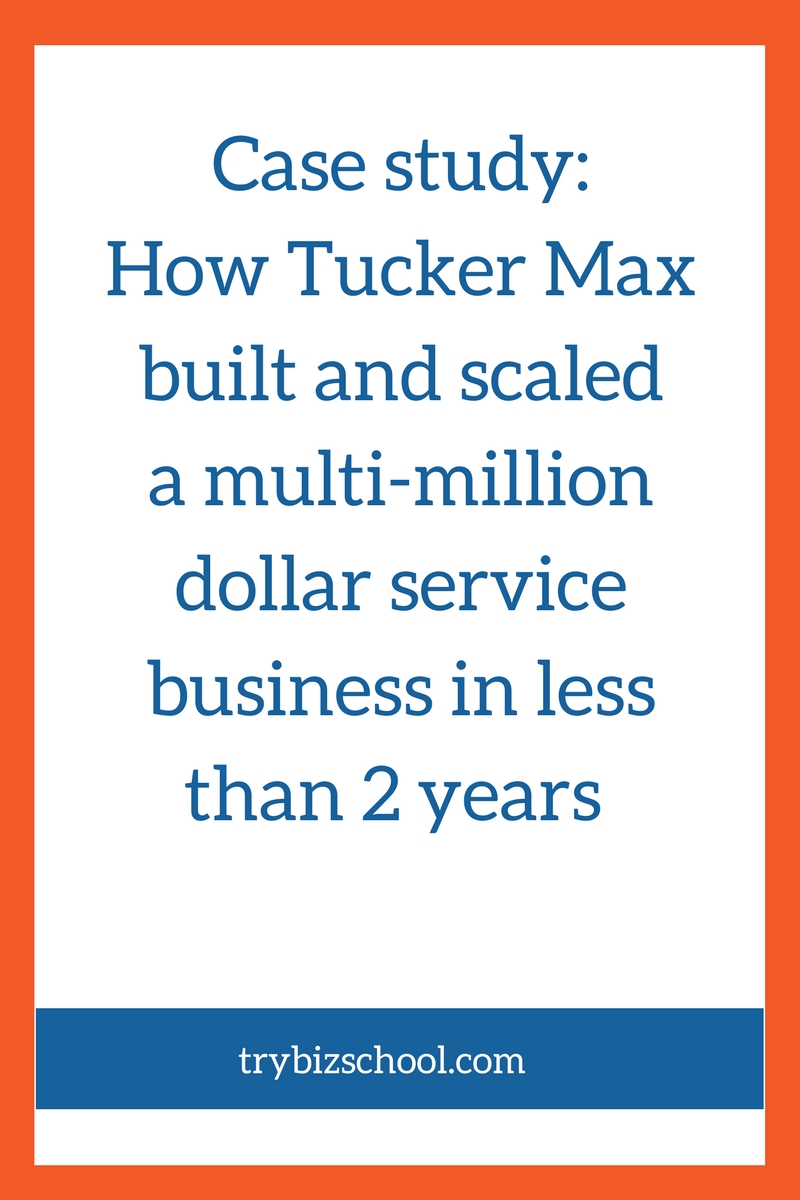“At the end of the day nobody cares.”
Pam was advising a colleague who was contemplating whether or not having a natural childbirth was right for her.
“Just do what’s best for you. Whether you do it natural or take the meds, you’ll still end up with a beautiful baby at the end. There’s no competition or brownie points for who can withstand the most pain during the birthing process.”
I listened to that conversation years ago while early on in my corporate career. Because I was so green and had not birthed a child, I wasn’t able to fully appreciate the wisdom in the advice.
But now as an entrepreneur I totally get: There’s no competition or brownie points for who can accumulate the most battle scars as you figure out how to build a business.
What matters is whether or not you build a business that makes life better for the people you seve. Feeling your own way just takes longer, adds a ton of frustration, and often costs you more money. No bueno.
The people who can benefit most from what your business has to offer need you to give it to them. And they need you to help them solve their problem now.
Don’t keep them waiting.
Instead, apply a proven process to help you get results faster.
A Proven Process to Build a Multi-Million Dollar Business
Processes aren’t the sexiest things to talk about. But they sure bring predictable and glamorous results over and over again.
The cool thing is, once a process has been validated, when new people use it, they should get the same results as the person who created it. Even if they don’t have the same level of experience.
A while back, I interviewed 3-time New York Times best-selling author Tucker Max for the I Am the One: Entrepreneur Edition podcast. He’s sold more than three million books, and they’ve been translated into more than forty languages worldwide.
Now he’s devoting his attention to his new company, Book-in-a-Box, which in less than two years, is already a multi-million dollar business that’s served more than 300 customers.
In the interview, I dove deep with Tucker to understand step-by-step what he did to build this new business and scale it up so quickly. It’s really simple, smart, and super valuable stuff.
And it is a process you can totally use to grow your business exponentially. It doesn’t matter what stage your business is in, or your level of experience as an entrepreneur.
Here are the steps Tucker followed to build his 2nd multi-million dollar business. Whether you want to build a business that makes five, six, or seven figures, following this framework will help you get there.
1. Find the burning pain
The best way to build a business people love to buy from, is to sell something they want to buy. Where business owners often get into trouble is when they get so focused on selling what they want to sell, intead of what the customer really wants.
So as you work on solutions your customers will love you for, you’ve got to start with their burning problem. Something they are just itching to get solved.
That’s exactly what happened to Tucker. Here’s how he figured out what his ideal client needed help with most:
The good news for you are that there are an abundance of problems that are just waiting for you to solve them. The challenge for you is figuring out how to recognize them when they show up.
All of them won’t be presented to you on a silver platter quite the way it was for Tucker. So you’re going to have to be dilligent about being on the prowl to make sure you’ve constantly got your finger on what it is your customers want from you.
Here are some additional ways to do that.
2. Walk a mile in your customers’ shoes
In most industries, there are a number of businesses that do the same thing. Take airlines for instance. All of them solve the same problem for their passengers, but some just do a better job than others.
The reason why?
Businesses that have a deeper level of understanding for their customers and the circumstances surrounding their problem have an advantage. That’s because they can apply that knowledge to build a better product, service, and connection with those customers.
Here’s Tucker empathizing with the challenges that prevent his ideal clients from publishing their books:
As you work to grow your business, you’ve got to know your customers better than anybody. Even better than they know themselves. When you do, you’ll be better positioned to help them like none other.
That means you’ll have to invest the time listen to what they say, watch what they do and don’t do, and as needed dive deeper into to the rationale behind it all through direct conversation.
This post and this one give you detailed steps on how to do that effectively.
3. Whip up your award winning secret sauce
The goal is to create a solution that solves your customer’s problem so well that it practically sells itself. You also need to ensure your product is differentiated enough from other similar offerings, that it’ a no brainer for your customers to choose you.
But the optimal solution won’t always come easy to you. You’ll have to spend some time considering a number of factors to find ‘the one.’
Here’s how Tucker figured out the system that makes Book-in-a-Box work.
Follow these steps to help you develop your own signature solution.
Reject the norm
A common thing people will do when they want to problem solve, is to just go look and see what everyone else is doing.
While this is helpful for research purposes, resist the urge to just copy what’s already being done.
That’s a recipe for lameness rather than awesomeness. And it’s also the reason why there are so many me-too products and so few breakthroughs.
While it is helpful to know what other options are available to solve your customers’ problem, this is only the starting point.
You want to look there to understand what currently exists, why it’s done that way, and then see if you can figure out what about those existing options don’t work for your customers.
Make strange connections
Don’t limit yourself to just your own industry for inspiration on how to tackle your customers’ issue. Look for inspiration in other areas.
Then bring them back and apply the techniques to your situation to see if it works.
Build upon your strengths
Tucker was uniquely suited to solve this book publishing problem, because he was a 3-time best-selling author. He knew what it took to produce a good book.
Add your secret sauce to the solution. What is it about your expertise and experiences that can add even more value to the offering that makes it even harder for others to duplicate?
4. Go to the lab
Once you’ve found something you think will work, validate it with a few customers to see what kind of results you get.
You don’t want to move too far down the path to ramp up and launch a product you’re not sure will work.
Tucker walked his first client through the process he developed, and it was a success. Once he had something that was workable, he knew he was in a position to move forward.
Here’s how he went about doing it:
You can test out the effectiveness of your product offering with a pilot program. Have a small group of people use your product or test your process. You can give them the product for free or at a lower cost in exchange for their feedback.
5. Clone yourself
After you validate that your signature solution works, next you need to document your process so it can be done multiple times by other people and still produce similar results.
It can be tempting to keep all this information in your head. But it is important for you to write down all the details of how you implement your process to make sure you don’t overlook anything.
This will make sure you don’t miss steps. As a busy entrepreneur with a lot of balls in the air, it’s easy to a miss a step here. This can happen even when completing a task you do all the time.
Utilizing documented processes helps you minimize the likelihood of those mistakes occuring. As a result, the effectiveness of your work will increase.
This step is helpful if you plan to be the only one doing the work. And it becomes even more critical if your intent is to scale the business to have other people do it on your behalf.
Here’s Tucker explaining in detail how he went about doing this for his business:
After you’ve got your process down, there is still work to be done. Over time, continue to work to refine and improve it so you’re able to improve your outcomes.
6. Get the right people on the bus (and in the right seats)
As an entrepreneur you wear many hats. And unless you are a unicorn, there are some roles you’ll be a rockstar in, and there will be others that you’ll suck at.
As you figure out the different roles you need to play, and the tasks you need to do to build the business you desire, you’ll have to do an honest assessment of yourself and your skills to see if you should be the one to do that specific work or not.
This assessment is critical to your success and growth.
As your team grows, you’ll have to do the same. You’ll need to make sure that you’ve got the right people on your team doing the right work.
Tucker and his co-founder took a hard look at their performance in their respective roles. And it resulted in them firing themselves. Check out the story:
7. Use the right words
Many entrepreneurs believe that all they need to do is develop a good product, and they can sit back and watch the sales roll in.
But the reality is, once you’ve got a product you know will produce results, that’s when the real work begins.
You’ve got to make sure the people who can benefit most from your product know about it, and understand how it can help them.
That means, you’ve got to develop a message that effectively communicates the features and benefits of your product.
Here’s how the Book-in-a-Box team talk about what they do:
Once you’ve got a message that works, then you’ve got to spread the word to make sure your ideal customers know about it.
The initial buzz about the Book-in-a-Box service first came through word of mouth. Then Tucker and the team started using content marketing to get the word out. This included publishing a book, being a guest on podcasts, and publishing articles around the web.
8. Pass out hugs
No matter what you sell, your business is about people. It serves people. And it needs people to operate.
So you’ve got to make sure that you put high priority on making sure the relationships you have with the people your business touches are strong.
Here’s how Tucker described it for his business:
Don’t let your relationships fall by the wayside. If it isn’t your strongsuit, make an effort to work on it. And if necessary, get someone to help you with this part.
9. Don’t drive on cruise control
Times change. Customers’ needs change. Your business needs to evolve to accomodate for that.
You’ve got to make sure you stay in tune to how your customers needs evolve over time, and how they need you to support them during that process.
So that means you’ll have to keep the day-to-day aspects of your business running, while keeping an eye on the future so you can grow and stay current.
Here’s what Tucker and his team have cooking at Book-in-a-Box, and how they are going about testing out their ideas:
You can grow your business exponentially
You don’t have to bumble around for years trying to figure everything out on your own. And you definitely won’t get any extra brownie points if you do. There’s a much easier way.
Skip the detours, and follow a proven process to build a thriving business.
It will make life better for you. And it will make life better for the people you serve.
Don’t make them wait any longer than they need to.
So don’t be stubborn.
Follow the blueprint. It works.
And then go buy yourself some brownies to celebrate. 🙂







